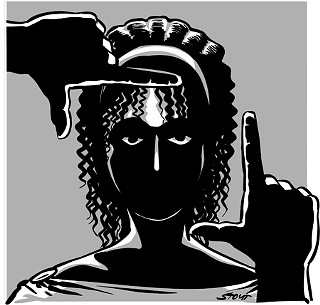Letters at 3AM
Contemplating the Close-Up
By Michael Ventura, Fri., April 24, 2009
Homer, the epic poet of ancient Greece, invented the cinematic close-up.
"What did that fool say?!"
Cinema's close-up of the human face is a magnified portrayal of an individual's response, the pure expression of a moment's consciousness in motion, the concept of individuality distilled into one shot – a strictly Western creation, probably because only a civilization that spent 3,000 years concocting a creature called the "individual" could come up with the close-up. So it's not enough to look to cinematic history for the close-up's origin. It's necessary to look not to the creation of individuality – we'll never know how that happened – but to the expression of individuality. In the West, that starts with Homer.
These days they figure Homer wrote The Iliad and The Odyssey in the ninth or eighth century BC, 300 to 400 years before the composition of Genesis. He created Western narrative by making the story of two great warring tribes into a story of distinctive individuals. Characters such as Odysseus, Achilles, and Helen overwhelmed the tale, while the warring masses faded into the background. So, by example, without need of philosophy, Homer stamped the idea of individuality on Western consciousness.
Then, in the fourth and fifth centuries BC, Greeks contributed to the close-up again by inventing democracy and theatre hand in hand. While philosophers experimented with the power of individuals, dramatists staged it. On the Greek stage, the individual is outnumbered by the ever-present chorus. But the chorus, the collective, merely suffers or enjoys its fate. It is never presented as capable of rising to the heights of tragedy. Tragedy, conceived as the highest plane of experience, is the realm of the individual.
But the thinker who contributed most to the creation of the close-up was a first century Jewish prophet named Jesus. He posits a personal, close-up relation to God. The radical statement is in the Lord's Prayer: "Forgive us our debts, as we forgive our debtors," asking God to agree to forgive me as I forgive others. Jesus reiterates this often, as in Mark 4:24-25: "The standard you apply will be the standard applied to you" (Scholars Version). What can that mean but that God is willing to judge me as I judge others? So who needs temples or priests? Jesus says it is better to pray alone in my closet. Previously, only prophets had direct congress with God. Jesus grants that power to individuals, literally enshrining the concept of individuality.
Well, who was ready for that? Quickly, individuals responding to Jesus were subsumed into the Church, which, relatively soon, would rule the Western world (insofar as any world is actually ruled). For a long time, the concept of individuality stayed stuck to the concept of God. In the early 1300s, Dante described some dandy individuals, but they existed only in relation to divine judgment. In the late 1300s, Chaucer related raunchy individuals who existed in the context of a religious pilgrimage. Then, circa 1450, Gutenberg invented the printing press, which spread all sorts of ideas throughout Europe until Oct. 31, 1517 – Halloween! That day Martin Luther nailed his challenge to the door of a church in Germany, and Church power cracked. An individual's more or less unmediated availability to God was again championed. The close-up was on its way.
By the end of Luther's century, William Shakespeare was creating a panorama of individuals unheard of in history. Hamlet, Lear, Lady Macbeth, Falstaff, Prospero, and on and on, kings and queens, gravediggers and fools, all equally allowed the dramatic close-up of soliloquy. In Shakespeare, belief in God is not a serious motivation for even one notable character. Shakespeare divorced the individual from any idea of God.
At the same time, Miguel de Cervantes quilled Don Quixote and revealed the power of the individual imagination to alter reality not only for oneself but for others. No sooner does Cervantes lay down his quill than the east coast of North America is settled by folks who, willingly or unwillingly, were children of the Magna Carta and the Enlightenment, attempting to remake a continent into the "city on the hill" that was their figment of imagination. Not a century and a half later, their descendants gave humanity the Declaration of Independence and the Bill of Rights – the idealization, perhaps beyond all reason, of the individual.
Meanwhile, in England, Henry Fielding, Jane Austen, William Makepeace Thackeray, and Charles Dickens were writing precise treatises (novels) about the relation of the individual to the collective. In their eyes, the individual is always outnumbered and is always most valuable. In America, Nathaniel Hawthorne, Henry David Thoreau, Ralph Waldo Emerson, Walt Whitman, Emily Dickinson, and Mark Twain assented. Karl Marx argued for the collective, but by the end of the 19th century, the concept of the individual was, or seemed, a definitive force in the West.
And that is precisely when the close-up appears. The mystery is: If individuality had taken such hold, why did the first narrative filmmakers see collectively, though the close-up was available to them from the first? In 1896, William Heise directed "The Kiss" for Thomas Edison: 47 seconds of a couple kissing in a close head shot, one of the first films shown commercially. It caused a sensation. Early filmmakers had to know of it and of Robert Bonine's 1902 "Grandpa's Reading Glass," in which children look at one another through a magnifying glass – a minute and a half of close-ups. But when narrative filmmaking began in 1903, stories were told through group shots. Photography and painting had long focused on individuals, but once the picture moved, it seems to have confused, as well. Isolating an individual's reaction within a narrative was difficult to conceive. Not until 1912 did D.W. Griffith experiment with a character approaching and looking directly into the camera, a kind of close-up in "The Musketeers of Pig Alley." Chaplin used a genuine close-up in 1914's "The Rival Mashers." Griffith employed two or three in 1915's The Birth of a Nation. But it would be several years more before the close-up, as we know it, was commonly filmed.
It was as though cinema was another, more intimate order of being in which individuality – the intensity of personal reaction – had to be redefined. When society was in far less flux, boundaries and rules between the individual and the collective were fairly (or unfairly) well defined. In the ever-faster 20th century, definitions shattered, boundaries blurred. Just as cinema understood what to do with the close-up in the 1920s, totalitarianism took hold in Europe. And so it has been since. The arts, with cinema and then music leading the charge, championed and inspired ideals (and excesses) of individuality, while government and corporate commerce pulled humanity in the opposite direction, a dialectic in which individuality seems steadily to have lost ground.
You see it in the novel. From Cervantes until the late 20th century, the job of the novel was to differentiate the individual from the group and examine prices paid for individuality. Now the novel as a form is seemingly in decline – perhaps we no longer want to dwell on the difference between individual and collective; perhaps it's too bewildering and painful because the individual, not the novel, is the antiquated form.
As for the close-up, in this era of Facebook, everyone is "ready for my close-up, Mr. DeMille," and everyone is their own DeMille, all in order to have so many "friends." Or is that just a longing to make "individual" and "group" mean the same thing? Has individuality become too frightening? Do we sense or fear collective disasters with which no individual is competent to deal? Was individuality a kind of fantasy all along and Homer dead wrong? Is the close-up that once expressed the individual now, on Facebook, individuality's stand-in within a crowd of "friends"?
But what is the close-up? It is what we see in the mirror, one's own face, unique and called upon, against all odds, to fulfill itself.









